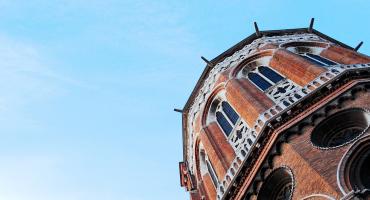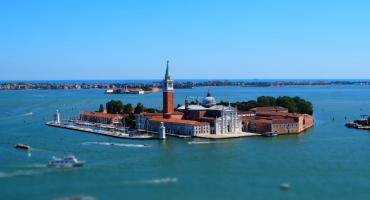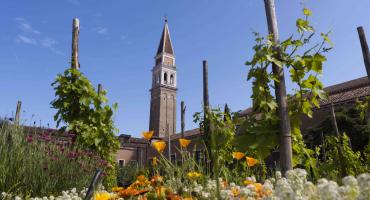A cloister… an image of young friars meditating or leafing through a Bible for hours before dawn. A sensation is a surge of peace and serenity. Venice: a city of canals, bridges, churches and monasteries where we’ll go to wander around, in an itinerary back in time, through cloisters of convents of Santa Maria Gloriosa dei Frari, Sant'Apollonia, San Francesco della Vigna and San Giorgio on Island.
1° stage: (1h) The church of Santa Maria Gloriosa dei Frari, that started in mid 13th century and finished 100 years later, is one of the most important city churches constructed of perforated brick and Istrian stone and with splendid decorations in fired brick in the typical Gothic lagoon style. Grandiose building which occupies a vast area including the convent with two cloisters and a complex building which is a head office of that exceptional Archive where all the history of Venice is preserved. Birth of the church is linked to that monastic movement that started in the first half of 13th century and which for a short time saw in our lagoon San Francesco of Assisi. Frari means Friars in Venetian. Under the spur of this presence many young friars went to Veneto and Venice. They lived dedicating their time to re-writing and binding manuscripts in exchange of sustenance. They used to sleep under the arcades of San Silvestro, San Lorenzo and San Mark or got accommodation from the congregation, until they had some land donated by the government where they started to build the convent and their cemetery. They had to do some land reclamation works since this area was marshy and low with a big pond cold “lake Badoer”.
It became one of three Franciscan centres in the city together with San Francesco del Deserto and San Francesco della Vigna and afterwards it was instructed by the government that the bell towers of above mentioned churches were to ring bells when the Great Council was to be appointed. Their importance grew in time housing “Schools” and getting rich with sumptuous chapels and doges’ tombs. The model of conventual’s palace of the Franciscans could be a Cistercian monastery: a quadrilateral with a cloister in the centre from which you had access to areas of common parts such as kitchens, refectory, workshops, laboratory etc.
In the specific instance of “Frari” two cloisters were built: one “external” called also Trinity or “of the dead” since there were burial places and it was accessible from outside. Next to it there were two rooms reserved for novitiates where youngsters aged 15 and 16 years used to pass their trial year: many documents give evidence of even considerable offers that the parishioners generously gave for these “novice brothers”.
On the other hand, the “internal” cloister was dedicated to San Antonio and around it in 1700 zincographic laboratories were set up by the cosmographer of the Republic: father
Coronelli. It bordered with a piece of land where the friars cultivated vegetables, fruit trees, sweet-smelling and officinal herbs that were needed for herbal medicine and grocery shops of the convent. There were many rose plants and one famous vineyard compensated for the friars’ needs. In the period of 15th and 16th century, during restoration works, the cloisters underwent some transformations too with columns and rounded arches supporting a balustrade terrace with statues, almost certainly based on a project by Andrea Palladio who, in the same period, looked after the buildings of Convents and Cloisters of San Giorgio Maggiore and Redentore. Two cloisters were supplied with wells placed in the centre and the water for them, in addition to the convent, used to get drawn from people of that area especially in case of necessity.
The church is obviously worthy of remarking for other beauties beside the cloisters, Canova’s mausoleum, Titian’s tomb, Carpaccio’s alter-piece, just to mention the main ones.
{mospagebreak}
2° stage: (1h 30') From Frari we pass through Rialto and arrive to San Mark, go around Basilica on the left and arrive to Ponte della Canonica (Vicarage Bridge) from where we can enjoy a splendid shot of the Bridge of Sights and the front of San Giorgio, which stands out between the water and arch of the bridge, here we find an access to the Cloister of S.Apollonia. A baord at the entrance says: “ Do you know the cloister of S.Apollonia? It’s a real stone cloister, with its small columns and its well… a small secret cloister, exposed to an order of slimmed and paired off columns just like the nuns when they walked in the sun on an empty stomach… (from: “The fire” by G.D'Annunzio).The cloister is part of the complex of one Benedictine ex-convent founded between 12th and 14th century. Entire construction was put under jurisdiction of the primicerius of San Mark that resided here. With the passing of time it deteriorated, got revived by the Procuratory of San Mark (1964) and afterwards repaired.
It is now an office of St Mark’s lapidary and Diocesan Museum of Sacred Art, the latter being recently restored and handed back to the city as a museum space. The cloister, whose arches on very small coupled columns are made of brickwork, refer to the architecture of Dome of S. Donato and Martyrium of S. Fosca on Torcello. Their remarkable craftsmanship marks the moment of passing from esarcale style to the Romanesque one in the Veneto lagoon.
In the centre there is a real well from 13th century resting on the herring-bone brick floor, one of the rare examples of ancient Venetian flooring. On the walls, a collection of decorative fragments of Roman and Byzantine origin or of Veneto Byzantine manufacture (IX-XI century) coming from St Mark’s Basilica.
There are interesting Corinthian capitals, pateras with bestiary, frameworks with vegetable, animal and geometric elements in the particular Byzantine workmanship called “straight stretch”.
With the latest restoration, this cloister has become a part of the Diocesan Museum, a new museum space where there are many important sacred art exhibitions set. Very interesting is the first exhibition on Tintoretto and the cycle of Saint Catherine.
3° stage: (1h) When we leave the cloister of S. Apollonia we turn towards San Zaccaria and then enter in Castello, Venice’s most densely populated and experienced area which has preserved its typical folklore to this day and we arrive to Campo di San Francesco della Vigna, where we’ll remain almost threatened by the imposing and orderly Renaissance façade of the church planned by Palladio. Its importance comes from the fact that different doges were buried here and whose chapels are enriched by works of renowned artists such as Pietro Lombardo, Paolo Veronese, Palma il Giovane and G. Battista Tiepolo.
The place where the church and the cloisters rise today were previously kept for a vineyard (to this day, the friars keep vineyards and a real botanical historic garden that overlooks the north lagoon), or for a big timber storage, as a “mark where archery was practiced” and a “riding school”, manège for noble Venetians that could house up to 70 horses. In 1253, this terrain got donated to the young friars of S.Francesco, by the son of the doge Pietro Ziani.
In 1534, the doge Andrea Gritti laid the first stone of the new church of S. Francesco to reaffirm his own intention to implement a program of building improvement in that area of Castello where in the neighbourhood there was a grandiose Arsenal thus it was a densely populated area and in need of a big church.
Inside of it, you can not stop admiring the altar-piece by Giovanni da Negroponte and Sacra Conversazione Dolfin (1507) by Giovanni Bellini, which is found in the small chapel opposite the biggest cloister. The monastery buildings are set between the church and the lagoon, where there appears a secluded cloister transformed in a garden, and they represent one of the most interesting examples of gothic architecture from 14th century.
Two cloisters which form the complex, besides the secluded one, are consecutive and the bigger one has got a direct access to the external square since it had cemeterial function given the presence of numerous tomb stones belonging to noble Venetian families such as Contarini, Zorzi, Correr, Gradenigo, just to mention some, and to distinguished figures.
The arcades constitute of a series of brick arches which rest on supple stone columns whose simple capital is surmounted by a kind of low dosseret. On the arches there rises the floor of dormitories whose distributive system by cells appears from the continuous series of small window equally distanced one from another.
We like to remember a legend about this church saying that Evangelist Mark found here his refuge during one stormy night and had a vision of an angel that greeted him with these words: ”Pax tibi Marce evangelista meus” (“Peace to you Mark, my dear evangelist”). These are the words which will later become the motto of the Venetian Republic and that can be found sculpted on the Gospel which the lion holds between his claws.
Nowadays these cloisters still have a very important function since they are being used for art installations and as exhibiting premises of the Venice Biennial Exhibition. In these structures, so engrossed and rich in history, concerts of classical music take place during summer nights, in an atmosphere of great imagination and magic, or you can simply take a break there reading a book protected by the arches on days of summer sultriness caressed by a breeze coming from the north lagoon…
{mospagebreak}
4° stage: (1h) At the end we arrive to the island of San Giorgio Maggiore, called so to distinguish it from another island in the lagoon: San Giorgio in Alga, known basically as “the island of cypresses”. Once upon a time here used to be vegetable gardens, vineyards, a salt marsh, a mill and an early church constructed in 790, dedicated to San Giorgio that gave it the name.
In the course of its history San Giorgio Maggiore had represented forVenice one of the most prestigious and liveliest centres thanks to the presence of Benedictine monks, welcomed here right from 10th century and who transformed the island from a fishermen’s place to a centre of spiritual commotion, cultural and artistic activities and a memorable place of meetings like the one between Federico Barbarossa and the Pontifex Alessandro III in 1177 or the conclave meeting in 1800 that elected Pontefix Pio VII.
The monumental buildings and artworks that the island holds are testimonies of works by the greatest masters who followed one another in the course of time, amongst which the works by Tintoretto: “Last Supper” and “The Fall of Mana” and by Veronese: “Marriage at Cana”, stolen from Napoleon and kept to this day in the Louvre museum.
The island and the monastery were subjected to big restoration works in the renaissance period; there is a building where used to be a dormitory and architectural structure of the cloister by Buora, once called “Laurels”, a wonderful example of renaissance architecture, loyal to the classical rules with its columns linked up to regular arches rising above coupled square windows (they correspond to the dormitory cells), to beautiful distanced mullioned windows with two lights and to big windows with one light of the Baldassarre Longhena library. The chapter house overlooks this cloister.
A renovation project of the monastic complex was defined in the same period and it got entrusted to the great expertness of Andrea Palladio. The architect from Veneto brought the church towards the basin opposite the Doges’ palace so that it could be admired in all its magnificence from the St Mark’s little square and from Riva degli Schiavoni. With arrival of Palladio the traditional loyalty to gothic shapes got broken and a completely new classicism was created that is entirely perceived in the white nudity of internal structures of the church and the cloister, called the “Cypresses”.
It was conceived as a quadrilateral with huge arches on coupled Ionic columns. Between this cloister and the next one there opens a monumental entrance of the refectory modelled by Palladian in an exceptional way. A grand staircase opens onto the Palladian cloister, accomplished in the mid 17th century by B.Longhena during restoration of Michelozzo’s library which got burned in a fire.
The entire structure can be appreciated, from the top of the bell tower, from where one of the most beautiful views over the city can be enjoyed, sweeping up to the island of the north and south lagoon. The grandiose complex, after centuries of decadence, became the Cini Foundation in 1951, which was created with an aim to re-give an impression of one time to the island and to entire convent so that San Giorgio Maggiore recovered its strength to such extent that it became an important reference for the international cultural activities of highest level.
Restructuring and modernisation of the island has continued to this day with an expert recovery project that is of interest to the ravishing Theatre Verde surrounded by the island and the water from St Mark’s basin. This place will shortly be re-opened with new museum spaces, laboratories and catering halls (there’ll also be a bar with tables from where the most beautiful view of the city can be enjoyed) which will become an even more important reference point in the quality cultural development in Venice.
Useful information and practical advice:
There are many places around these cloisters where you can stop for a break or have a lunch at reasonable price. We recommend “Bar al Topo” in Fondamenta dei Frari, “La Patatina” near Campo S. Polo or “Al Baffo” in Campo San Stin for a “cicheto” or “ombra”. For a fancy cake: the cake shop in Campiello dei Meloni.
Other places are in the Rialto area like “la Naranzeria”, “il Bancogiro”, “il Sacro e il Profano”, “la Botte” in Campo S. Bartolomeo. Avoid eating in the area of St Mark.
Close to San Francesco della Vigna you can cross Barbaria delle Tole where there are typical taverns amongst which also one “fritolin” (traditional Venetian food) and then we suggest a coffee and a sublime cake in the cake shop Rosa Salva in Campo S.S. Giovanni e Paolo with tables turned towards polychrome stained-glass windows of the lateral aisle of the church. For a really special lunch don’t miss the family tavern “Da Dante” where you can eat excellent homemade dishes of Venetian tradition in a charming garden inhabited by cats and decorated with ivies of centuries old looks, frequented by local people and gondoliers on their break, and if you get lucky you can join in a real Goldonian scene of modern times…and don’t forget a Veneto/English dictionary because you won’t be able to understand anything but from the tones you’ll understand the alcohol level of the onlookers…
S. Maria Gloriosa dei Frari: entrance fee
S. Apollonia: 1,00 € to visit cloister
S. Francesco della Vigna: free entrance
S. Giorgio on island: church free, 3,00 € bell tower
By A Friend in Venice
(Serena Bagnai, Patrizia Fella, Orietta Girotto, Nicoletta Possumato, Daniela Simionato)
www.unamicoavenezia.it



